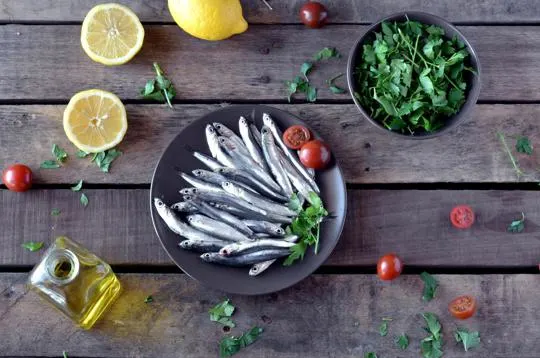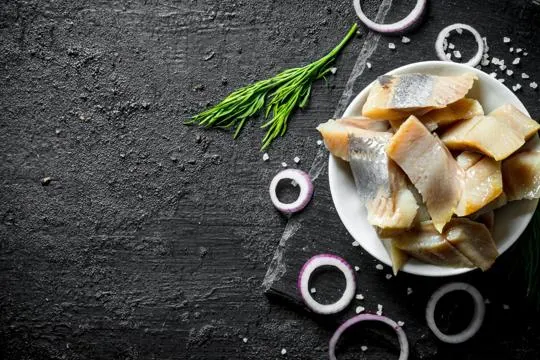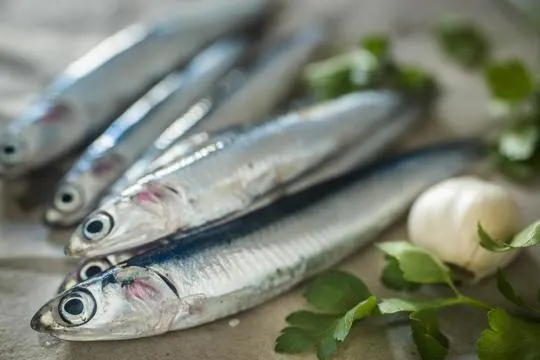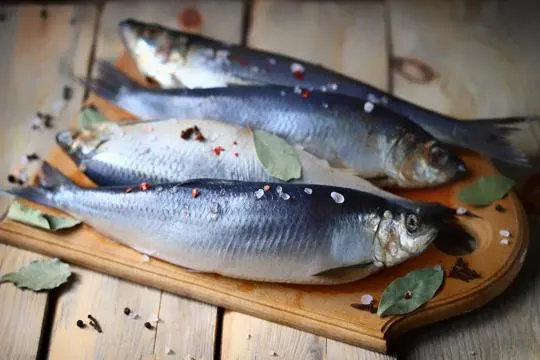Anchovies and herring. We often mix them up.
First off, they’re both fish. That’s the easy part. Now, here’s where it gets interesting. Anchovies are the tiny flavor bombs we love on pizza. Herring? Larger, less intense, often found in cans or at fancy brunches as kippers.
We’ve had our battles at the supermarket aisle, debating over jars and tins. Our secret? We once used herring instead of anchovies in a Caesar salad. The result? Surprising. Not the disaster we expected.
Size matters in this case. And flavor. Oh, and how they transform a dish from “meh” to “wow.”
Stay with us as we dive deep. It’s a fishy business, but someone’s got to do it.
What are Anchovies?

Anchovies are a real treasure from the ocean.
They’re small, oily fish, and part of the Engraulidae family.
They live in temperate waters.
Not everyone loves anchovies, but their unique taste and versatility make them a go-to for many chefs.
They’re about 2 to 4 inches long.
They have a silver-green hue and small scales.
Plus, they have a distinct pungent smell.
Yet, despite their size, anchovies are flavor powerhouses.
Their high oil content makes them great for preserving and curing, which is why you often find them in jars or tins, packed in salt or oil.
You can use anchovies in many dishes.
They work as main ingredients or to add umami to sauces, salads, pizzas, and dressings.
Anchovy paste is also popular for giving soups and stews depth.
What is Herring?

Herring is a fish from the Clupeidae family.
It has a slim, streamlined body for swimming swiftly.
These fish can be found in freshwater and saltwater all around the world, such as the Atlantic, Pacific and Baltic seas.
Humans have harvested herring for centuries.
It’s a popular food, like pickled herring and herring fillets, because of its high oil content providing a rich flavor.
Herring can eat zooplankton, small fish and crustaceans.
This flexibility helps them survive in different environments.
Herring are important in marine ecosystems.
They are prey for bigger fish, birds and marine mammals.
Plus, their abundance shows the health of aquatic habitats.
Differences Between Anchovies and Herring

Anchovies and herring may look alike, but they’ve got some major differences.
Physical Characteristics
Anchovies and herring have physical characteristics that set them apart.
Anchovies are usually streamlined with silver scales and blue-green backs.
Herring have a more elongated body structure and silver scales with a bluish or greenish hue.
Anchovies have more pronounced vertical lines running along their bodies than herring.
In terms of size, anchovies measure 3 to 6 inches long while herring range from 8 to 12 inches.
This size difference affects their habitat preferences too.
Each species has its own unique traits.
For example, anchovies have a protruding lower jaw which helps them catch prey.
Herring have a deep keel or ridge along their bellies that helps them swim.
Flavor and Taste
Anchovies offer a rich, umami flavor with hints of saltiness and a fishy taste.
Herring, in contrast, comes with a milder yet robust flavor profile; delicate sweetness and subtle brininess.
Anchovies have a strong and pungent aroma that can lift salads, pasta sauces, and pizzas.
They add depth to recipes for an intense and flavorful experience.
Herring is more subtle and versatile – used in raw preparations like pickled herring and cooked dishes such as stews or pan-seared fillets.
It boils down to personal preference.
Some may love the punchy taste of anchovies, while others may prefer the milder herring.
Both fishes offer unique flavors to experiment with in the kitchen.
Anchovies bring boldness and herring brings delicacy – both can make dining experiences more vibrant with their distinct tastes.
Culinary Uses and Preparation
Anchovies and herring may look similar, but their culinary uses and preparation are very different.
Anchovies are often used as a flavoring in many dishes, like sauces, dressings and pizzas.
They bring a unique umami flavor to any recipe.
Herring is usually pickled or smoked, often eaten alone or added to salads and sandwiches.
You must remember that the intensity of anchovies is strong.
A little bit can make a big difference.
You can also mash them with olive oil, garlic and lemon juice to make anchovy butter.
This spread can add flavor to grilled meats and vegetables.
Herring has its own special qualities when it comes to preparation.
Pickled herring is marinated in vinegar-based brine with spices like onions or dill.
It makes a great snack with crackers or bread.
Smoked herring gives a smoky aroma, which can be enjoyed on its own or with cream cheese or cucumbers.
Anchovies and herring both offer something special.
When you come across them, consider traditional recipes or try something new.
There are endless possibilities.
Nutritional Differences
Anchovies and herring have unique qualities. They differ in nutrition.
Anchovies are high in omega-3 fatty acids, calcium, iron, and magnesium.
Herring is rich in vitamin D, B12, and selenium. Anchovies offer more protein.
Herring provides phosphorus. Both are low in calories and fat.
The choice depends on individual needs and preferences.
Knowing the nutrition of each helps in making informed decisions about including them in the diet.
Omega-3s or vitamins and minerals, both offer valuable benefits for health.
Similarities Between Anchovies and Herring

Anchovies and herring – both from the Clupeidae family – have similar traits.
They are both small, oily fish with shimmering silver scales, and both have high omega-3 fatty acid content.
But they differ in their habitats and flavors.
Anchovies live in warmer waters like the Mediterranean Sea or Pacific Ocean and have a strong, umami flavor.
Herring, by contrast, prefer cold environments like the North Atlantic, and have a mild flavor that tastes of fresh fish.
In terms of culinary applications, anchovies are often filleted and preserved in salt or oil.
They are used as seasoning for their intense flavor.
Herring can be pickled or smoked whole and served as a main dish or topping.
So, anchovies and herring share several traits, yet also have differences that allow us to enjoy and appreciate each one’s unique qualities.
Popular Dishes and Recipes with Anchovies and Herring
Anchovies and herring are two popular seafoods.
Their unique flavors and textures make them a hit with seafood lovers.
Anchovies offer an intense salinity, while herring has a softer taste.
In Mediterranean cuisine, anchovies are often used in dishes like Caesar salad or tapenade.
They add a salty flavor that enhances the taste.
They can also be used as pizza toppings or added to pasta sauces.
Herring is a classic dish in Northern European cuisine.
It’s often served pickled with vinegar, onions, and spices.
Other ways to enjoy herring include smoked, grilled, or fried with potatoes and vegetables.
Both anchovies and herring make great pâtés or spreads.
Enjoy on toast or crackers as an appetizer or snack.
Or add to salads for extra flavor.
Nutritionally, both fish offer numerous benefits.
Anchovies are high in omega-3 fatty acids and a good source of protein.
They also contain essential vitamins and minerals.
Herring is high in omega-3 fatty acids, vitamin D, and vitamin B12.
It’s also a good source of selenium with antioxidant properties.
Conclusion
After weighing all the various factors discussed in this blog post, it’s clear that anchovies and herring are two fish species that differ from one another in many ways.
Anchovies are slimmer and blander compared to herring, plus they rarely offer as much culinary versatility.
Herring, on the other hand, is larger, boasting a strong flavor that’s perfect for smoked fish dishes or hearty stews.
They also supply an ample dose of omega-3 fatty acids—plus they can be found nearly everywhere.
Ultimately, the decision between these two seafood options comes down to preference: do you prefer mild or intense flavors in your food?
More importantly, what dish are you planning to make with either anchovy or herring?
Whether it’s Sicilian pizza with salty anchovies or gefilte fish with succulent herring, there are sure to be plenty of delicious recipes awaiting you.

Leave a comment